What Is A Camera Lens
Lenses. They're arguably the nearly important piece of equipment a photographer tin buy – even more than important than the camera itself. But what makes lenses so useful? Why are some camera lenses so much improve than others? The answer goes across simple things like sharpness and prototype quality. Instead, lenses matter because they control which photos you can even take in the first place.
Table of Contents
1. The Anatomy of a Lens
Modern lenses look something similar this:
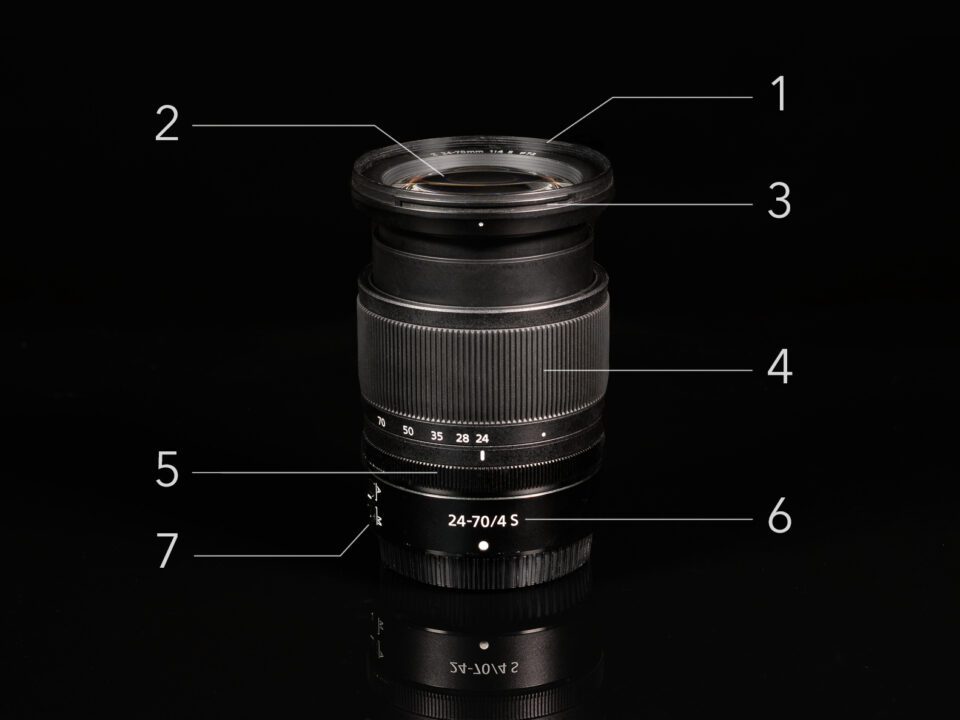
Each function of the lens serves an of import purpose:
- Filter thread: Lets you attach lens filters to modify light that reaches your photographic camera sensor
- Front chemical element: Collects low-cal and bends it to the other lens elements
- Lens hood thread: Lets you lot adhere lens hoods to cake sunlight and reduce flare
- Zoom band: Rotates to zoom the lens in and out
- Focus band: Rotates to focus manually; does not rotate when camera autofocuses
- Lens name: Identifies lens
- A/M switch: Switches between autofocus and manual focus
Not every lens has all seven of these features, and other lenses have many more than this. However, the lens above is adequately representative of modern zoom lenses.
2. Camera Lens Terminology
Nigh lenses today are named in a relatively standard manner:
- Brand proper name, lens type, focal length (in mm), maximum aperture, other lens features/abbreviations.
For example, the official proper noun for 1 of Nikon's professional zooms is the "Nikon AF-S 24-70mm f/2.8 Due east ED VR" lens. Canon'due south equivalent is the "Canon EF 24-70mm f/2.viii 50 II USM" lens.
The most important terms are focal length and maximum discontinuity. In other words, the "mm" and the "f/number" terms. These numbers are the well-nigh directly related to the types of photos you will be able to capture with the lens. (I've got a full department after on each one and why it is so important.)
What about the abbreviations at the end of the lens name? They even so thing, denoting the extra features offered by each lens. For example, the "VR" term in the Nikon lens stands for "vibration reduction," which stabilizes the lens for handheld shooting. Nonetheless, these other terms are ordinarily secondary in importance. Some don't even refer to a specific feature, but instead are solely for advert value (such as "50" on the Canon lens, which simply means information technology is one of Canon's high-end lenses).

Thanks to this telephoto lens's vibration reduction feature, I was able to handhold it at one/twoscore 2nd and still capture a sharp photo.
The main exception to the "mm and f-number thing most" dominion is when you're dealing with specialty lenses. With fisheyes, macro lenses, tilt-shifts, and and so on, your main reason for buying the lens has more than to do with its unique feature than anything else.
So, what practise all the abbreviations at the end of a lens name correspond? Each visitor labels its lenses in a different way, with potentially dozens of abbreviations per manufacturer – too many to fit in this article. Notwithstanding, we've covered all the various terms for many lens manufacturers the post-obit guides:
- Nikon lens abbreviations
- Canon lens abbreviations
- Sony lens abbreviations
- Fuji lens abbreviations
- Sigma lens abbreviations
3. What Is Focal Length?
The near important specification for most lenses is their focal length – in generic terms, how far "zoomed in" the lens is. Focal length is written in millimeters.
Some lenses only take a single focal length. These are known as prime lenses. A popular example is the 50mm lens – a very mutual offset prime lens for photographers, thanks to its high usefulness and depression price.
Other lenses are zoom lenses, significant that they cover a range of focal lengths. For example, the about mutual zoom lens on the market is an xviii-55mm kit lens (sometimes 18-50mm or similar). These lenses zoom from a relatively wide angle (18mm) to a moderate telephoto (55mm). If you lot dissever the lens's longer focal length by its wider focal length (like 55/18), so you lot go the lens'due south zoom ratio (like 3x).
Also come across our article primes vs zooms.
A few specialty lenses on the market place fit somewhere between primes and zooms, such every bit the Leica sixteen-xviii-21mm f/four lens. This lens covers three specific focal lengths – 16mm, 18mm, and 21mm – just none of the focal lengths in betwixt. This is reverse to a normal zoom lens, which smoothly zooms from its widest to longest focal length.
The technical definition of focal length is a fleck messy, and across the scope of this article. Elizabeth wrote a comprehensive guide to focal length that explains everything at a technical level.
We also have full articles introducing wide bending lenses and telephotos.
iii.1. The Impact of Photographic camera Sensor
I'll note apace that the sensor size of your camera contributes to the apparent focal length you're using. This is because small-scale camera sensors are like crops from a large camera sensor. Put the same lens on both, and the lens volition appear more zoomed in on the small sensor.
Cameras with a larger ingather factor (i.e. smaller sensor) will exhibit this effect the most. You tin calculate the exact corporeality simply by multiplying your lens focal length by your ingather factor. So, an xviii-55mm lens used on a Nikon DX sensor – which has a 1.55x crop factor – is equivalent to a 28-85mm lens on a larger full frame photographic camera sensor.
This is also why you can't only say that a 28mm lens, for example, is a wide-angle. On some cameras, it is more like a medium lens, and on others it'southward even a moderate telephoto. You have to specify 28mm equivalent.
Here'southward a general guide:
- Wider than 35mm (equivalent): Wide bending lens
- 35-70mm (equivalent): Normal lens
- Longer than 70mm (equivalent): Telephoto
Anything wider than 18mm and longer than 300mm is generally considered an ultra-wide or a super-telephoto. (On Nikon DX and other APS-C cameras, that would be wider than 12mm and longer than 200mm.)
All of these are crude figures, though. Some photographers may consider 35mm to be broad angle rather than normal, or vice versa, and it's not a large deal either manner.

Taken at 17mm. Since I used a DX camera (the Nikon D7000), this is only a moderate wide angle. On total frame, 17mm would exist ultra-wide.
4. What Is Maximum Discontinuity?
The other critical term in a lens proper noun is the "f/number" term, which stands for the lens's maximum aperture.
Commencement, if y'all are unfamiliar with the concept of aperture, I recommend reading our beginner'south guide to aperture. In curt, aperture describes the "pupil" of your lens. Just like the pupil in our eyes, the discontinuity in a lens will let in more or less light. It is quite an important specification.
Many photographers don't realize that aperture is written equally a fraction. This is why f/2 is larger than f/4 – it's just like 1/2 beingness larger than i/four. Expensive lenses often have large apertures to permit in a lot of lite (again, similar a large pupil). For that reason, a 24-70mm f/two.8 zoom is going to be more than expensive than a 24-70mm f/4 zoom in practically every case.
In full general, prime lenses have a larger maximum aperture than zooms, especially at a given price. Information technology's one major reason why photographers use primes. Zooms usually max out at f/two.8, while plenty of primes on the market go to f/1.4 and sometimes wider. This means prime lenses can permit in 4x as much light as the best zooms.
Of class, even though a lens name will include its maximum discontinuity, you aren't restricted to using that aperture alone. You can always change the aperture to be smaller if you lot want. Well-nigh all lenses go down to at least f/16, while many permit f/22, f/32, and beyond. This is called minimum discontinuity.
Minimum discontinuity isn't most as important as maximum discontinuity, though. It'due south why yous only come across maximum aperture in the lens name. If you use extremely small apertures, especially f/22 and beyond, you start to add blur throughout your photos and darken them more than you'd normally want.
Equally with focal length, here's a general guide to aperture:
- Wider than f/ane.4: Extremely big aperture
- f/1.4 to f/2.8: Large discontinuity
- f/4 to f/8: Normal aperture
- f/xi to f/22: Small aperture
- Narrower than f/22: Extremely small-scale discontinuity
4.1. Depth of Field
The other reason why maximum aperture is so important is that information technology impacts your depth of field. Large apertures like f/1.4 and f/2.8 volition give you more of a "shallow focus" effect, where the groundwork is blurred and your subject is sharp. This is very mutual to encounter in portraiture and still life photography.
Depth of field is also influenced by the lens's focal length. Telephoto lenses have a shallower depth of field than wide angles. So, if yous really desire to blur the groundwork of your photo as much equally possible, you'll want at least a 50mm f/1.8, and probably something like an 85mm f/1.8, 85mm f/1.four or 105mm f/one.four. But those lenses also get progressively more and more than expensive.

4.two. Variable Aperture Zooms
Some zoom lenses take a unlike maximum discontinuity at their wide angle and telephoto ends. These are chosen "variable aperture" lenses. For example, the 18-55mm zoom I talked about earlier ordinarily is f/three.5-five.6 variable discontinuity. If you shoot at 18mm, you lot can use an aperture as wide as f/3.5. If yous shoot at 55mm, you can use an discontinuity as broad as f/5.6. (At focal lengths in between, your maximum discontinuity gradually changes from f/3.5 to f/v.vi.)
Variable aperture lenses don't accept the best reputation. In part, this is because it is annoying to have different discontinuity limitations throughout the zoom range. Just all lens designs have trade-offs, and variable aperture is hardly the worst compromise out there.
In fact, these lenses can be smaller and less expensive than constant aperture zooms, making them quite reasonable in many cases. And then, don't avoid variable aperture zooms by default. Instead, wait to other features of the lens, too, to see if information technology's a expert fit for you.
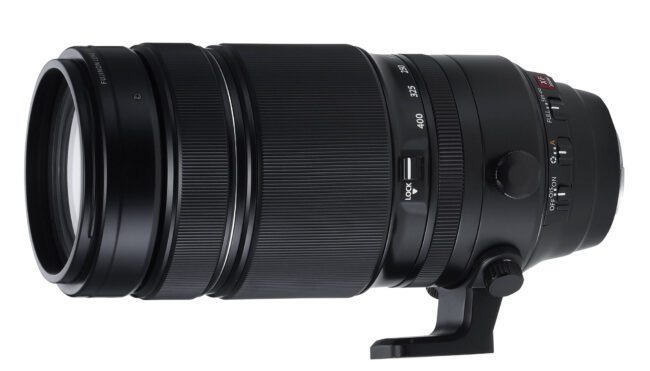
5. Important Lens Features
When I buy a lens, I don't look at prototype quality kickoff. Instead, in that location are other factors which matter more.
Kickoff: size and weight. I'm willing to give up some paradigm quality – as well as things like zoom range and maximum aperture – to get a lighter weight lens. Of course, finding a lightweight lens can be a bit deceptive. If ane heavy zoom lens replaces iii moderately heavy primes in your kit, the zoom isn't really heavy at all. Or if two lenses are equal in weight, but i goes with a lighter camera arrangement, information technology'due south nevertheless got the advantage.
On peak of that is autofocus. Not all lenses take autofocus, and not all autofocus lenses are equally fast and accurate. It doesn't matter every bit much to some genres as others, just if y'all're a sports photographer, chances are good y'all're willing to pay for top-notch autofocus performance.
There are tons of other lens features that thing in photography. A big 1 is durability/weatherproofness. If you can use your lens for several years in tricky conditions, information technology'southward worth much more than than a lens that can't handle being bumped around.
The overall ergonomics of the lens also affair quite a scrap. This includes everything from the position of the zoom band to the smoothness of the focus ring, and how seamless it is to use the lens. You might not notice lenses with skillful ergonomics, but you'll certainly detect bad ones.
And, naturally, all of these factors tie intoprice (same every bit the next section, image quality). Equally dainty every bit the Zeiss Otus lenses might look to y'all, it'southward probably more reasonable to go with a Nikon or Canon lens that fits the same focal length.
5.1. Structure
Of all of these concerns, i of the most important and easiest to overlook is but the lens'southward construction. Lenses with the fewest number of moving parts (i.e., internal focus and internal zoom) are generally ideal, since it allows for fewer points of failure. The aforementioned is truthful for lenses which are weather sealed; it's worth paying more for a lens that will terminal longer.
I'll also mention the distinction between metallic vs plastic lens construction. Typically, metal lenses are seen as college-end and may command a college cost because of it. However, I personally prefer high-quality plastic lenses instead. They counterbalance less, deal better with bumps, and don't get as common cold in bad weather. Metal lenses may be more durable in sure situations, but generally there is nothing wrong with plastic lenses in this regard.
Although you lot pay a bit of a toll for better structure lenses (both in dollars and in weight), it'due south worthwhile in the end, since you may save yourself from needing to buy a replacement.
vi. Lens Image Quality
There are dozens of image quality factors that brand some lenses better than others. I'll go through the nearly important below.
Get-go, though, continue in mind: lenses with farthermost specifications are more probable to have compromises than their relatively ordinary counterparts. I'yard referring to everything from superzooms to lenses with especially wide apertures. Although compromise tin take many forms, it usually ways lenses with lower image quality or a college size/weight/toll.
6.one. Sharpness
Right or wrong, the top characteristic on everyone's heed when a new lens comes out is sharpness. The good news is that mod lenses are sharper than ever. The limit of sharpness in your photos is very likely to be your technique, not your lens.
Today, every new lens is abrupt at f/8 in the center.
On top of that, most new lenses are sharp at f/8 in the corners. The aforementioned is true at their maximum aperture (any it may exist) in the middle.
The main area where modern lenses can be unsharp is at their maximum aperture in the corners of the frame. This is hardly relevant to most photographers. If you're shooting at f/1.iv, y'all're likely to become a shallow focus effect. And in that case, the corners wouldn't be abrupt anyway, so your lens'due south corner sharpness is irrelevant. (Milky Way photography is one exception. If you're non a Milky Style lensman, you probably don't need to worry about corner sharpness at f/1.4.)
Personally, my principal concern with sharpness for landscape photography is that the lens remains precipitous in the corners at f/eight to f/xi, my nigh common discontinuity range. Although almost all lenses pass the "adequate" threshold, some do better than others. I don't intendance nigh small differences, merely a bad lens here will not end up in my bag.
6.2. Distortion
Distortion means that the lens introduces a "bulge" or "pinch" to straight lines in your images. The most obvious example is a fisheye lens, which has dramatic levels of baloney (specifically barrel distortion). If you photograph the horizon or any other flat line in your photograph, a loftier distortion lens will show noticeably curvature or waviness.
The three main types of distortion are pincushion, barrel, and mustache. A depiction of each is below:
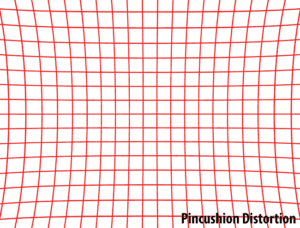
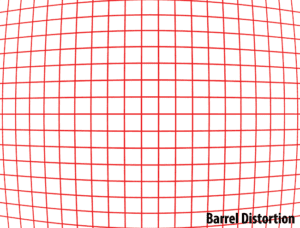
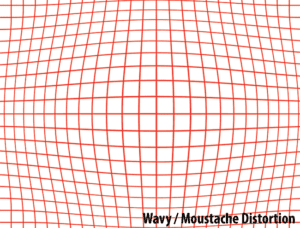
Although it's not great to have a high-distortion lens (aside from fisheyes), this is hardly the most concerning image quality issue out in that location. Most photography software has built-in distortion correction that tin set up the problem in i click. This tin damage corner sharpness a chip, and change your composition slightly, but that's a minor toll to pay.
6.2.1. Perspective Distortion
1 type of distortion you'll hear nearly is called perspective distortion, but it's not the same as the distortion above. This one is non an image quality issue; it has to practise with stretched-out proportions in your discipline that can happen if y'all become too close. It'due south peculiarly visible if you lot use a wide angle lens, since you lot demand to go much closer to your subjects than with a telephoto:

This is why well-nigh portrait photographers prefer an 85mm lens rather than a 24mm lens for headshots. You can make full the frame with your subject area in either case, but you demand to get far closer to your subject with the 24mm. This introduces a lot of perspective distortion.
6.iii. Chromatic Aberration
Despite the intimidating proper noun, chromatic aberration actually does merely mean "color trouble." It refers to color artifacts a lens introduces, like carmine and blue fringes in the corners of your epitome. Hither'southward an obvious example:

The example above is called lateral chromatic aberration. There is also such a affair every bit longitudinal chromatic aberration. In that case, out-of-focus regions are the ones irresolute colors. Specifically, they get greener behind the subject and purpler in front of it:

Information technology is easy to right lateral chromatic aberration (the start one) and harder to correct longitudinal chromatic aberration. Most photography software will have some tools to assist minimize it, however.
6.four. Bokeh
If you lot shoot shallow focus photos, bokeh will be an important concern for y'all. This is simply the quality of a photo's out-of-focus blur. Information technology was one time a very specific photographer in-group term, then Apple used it in a commercial, and now information technology's pretty widespread. Yet, y'all may desire to bank check out our full article on the subject.

Some lenses have better bokeh than others. Yous'll read about information technology in any reviews of those lenses, no dubiety. Bokeh is generally considered to exist adept when it has minimal texture and soft transitions, although all photographers take their own preferences.
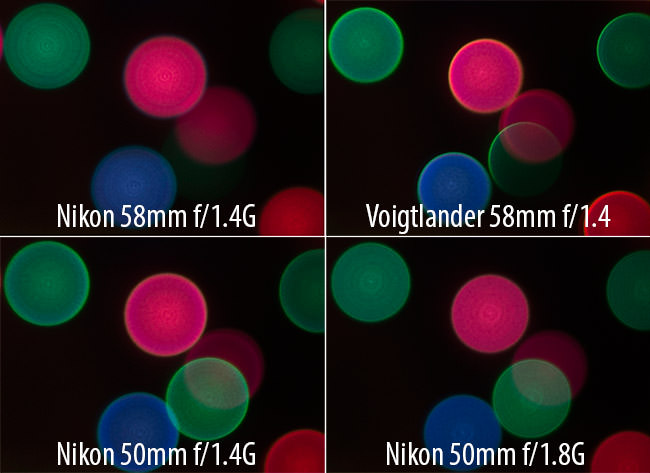
6.v. Flare
When y'all signal your lens at the dominicus, information technology has the potential to create internal reflections or flare that shows up as blobs in the photograph. Brilliant sources of light can also reduce the photograph's overall contrast and make it wait besides hazy.
The best lenses will accept high-quality coatings that minimize flare. It doesn't apply to every photograph, but it's a big deal when you're working in a backlit environment. As a landscape photographer, this is definitely one of my principal concerns when because a new lens.
The sun doesn't actually need to be in your photo in order to innovate flare. Sometimes, yous tin go dots of flare just by pointing the lens vaguely toward the light. Although this is a good reason to use lens hoods, it'southward too a good reason to buy a lens with minimal flare.

6.6. Sample Variation
Some other component of epitome quality is sample variation – the idea that all copies of a detail lens fall within a like range of image quality. Information technology would be very frustrating to read a good review of a lens online and find that yours isn't near equally impressive.
Some lenses have smaller sample variation than others. This is something nosotros try to include in our lens reviews by testing multiple copies of the same lens, but there is also plenty of luck involved. If one in x copies of a lens is bad, most reviewers volition never notice, only a high percentage of users will.
There's no great way effectually sample variation, aside from testing your lenses. If you find that one or two corners are significantly less sharp than the others, that'southward the best indication of a bad copy of your lens. See our manufactures on what to do when you become a new lens and on lens decentering.
vi.7. Other Image Quality Concerns
Along with the list in a higher place, there are enough of more specialized epitome quality concerns when yous get a new lens: focus shift, field curvature, starburst performance, astigmatism, and and then on.
All the same, the more you concern yourself with incidental image quality differences between lenses, the farther yous move from real, practical concerns. It is not that these features are unimportant, but that they are only worth worrying about if a lens is far outside the norm on any of them.

7. Third Party vs Name Brand Lenses
Alongside lenses fabricated by camera manufacturers like Nikon, Canon, Sony, and so on, endless 3rd-political party companies make lenses, likewise. Are these ever worthwhile choices?
On i hand, if a 3rd-party visitor makes a lens that your camera company does not, it plainly is worth because. For example, Sigma makes an xviii-35mm f/1.8 zoom lens – notation the wide maximum aperture of f/1.8 – for APS-C cameras. It has no equivalent from the photographic camera manufacturers.
But many third-party lenses are similar or identical in focal length and maximum aperture to lenses from camera companies. In that example, the 3rd party lens is usually (though non always) less expensive. Is it worth saving that money, or are you lot paying for third-party lenses some other way – through their lack of quality?
In this case, it very strongly depends on the lenses in question. In general, third party lenses accept a bit more potential for autofocus issues than name-brand lenses. They also do not e'er have immediate compatibility with new cameras, or camera firmware updates (although their manufacturers usually release compatibility as shortly every bit possible).
To me, these problems are relatively pocket-sized. I generally ignore them and compare the lenses on other features instead.
For example, how good are reviews for each lens? Does either option – name brand or tertiary party – take poor sharpness, flare, distortion, or other bug?
Although a lot of third-party lenses several years ago had the reputation of low manufacturing standards and bad epitome quality, that has largely inverse today. My favorite broad angle zoom is a Tamron lens (the fifteen-30mm f/two.viii), and my sharpest lens is a Sigma (the 50mm f/1.4 A).
Yous still need to exercise your enquiry. There are some bad third-party lenses floating around, merely like there are some bad name-brand lenses. Near – but not all – will be the companies' older offerings.
Simply I'll get ahead and say that the boilerplate, new third-party lens is no amend or worse than its equivalent proper noun-brand lens. Some are better, some are worse. You don't have anything to fearfulness past going this route, if it suites your budget and your photographic needs.
8. Conclusion
Hopefully this article gave you lot a practiced understanding of lenses – how they work and what to look for when you lot buy ane. There's a lot of information to digest, but lenses are worth learning. In many cases, they actually are the near important slice of camera equipment y'all can purchase.
If you have any questions or comments, feel gratuitous to allow me know below and I will endeavour to get back to you!
Source: https://photographylife.com/camera-lenses
Posted by: cooktheartumety.blogspot.com

0 Response to "What Is A Camera Lens"
Post a Comment